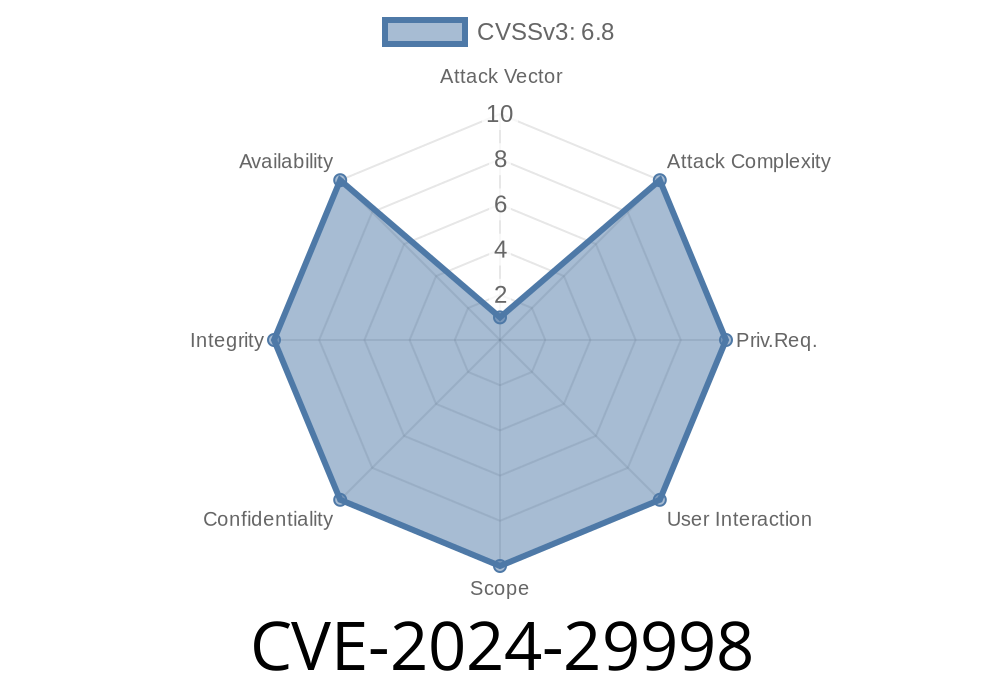In early 2024, a critical security flaw caught the attention of Windows users and cybersecurity professionals: CVE-2024-29998. This vulnerability impacts the Windows Mobile Broadband (MBB) driver, exposing millions of laptops and tablets to a serious Remote Code Execution (RCE) risk. In this article, we'll break down what CVE-2024-29998 is, why it matters, how attackers exploit it, and what you should do to protect your system.
What is CVE-2024-29998?
CVE-2024-29998 is a vulnerability in the Microsoft Windows Mobile Broadband driver (mbbclass.sys), used by Windows for connecting to cellular networks. If exploited, an attacker can run malicious code on a target computer remotely — potentially giving them full control.
Why is this vulnerability so serious?
- Remote: It can be triggered over the air or via crafted network packets (sometimes even just by being within cellular range of a malicious base station).
Privileged: The driver runs with SYSTEM privileges.
- Appears on default Windows installations: Many recent Windows 10 and 11 systems include the affected driver out of the box.
How does the exploit work?
The vulnerability exists because the MBB driver improperly parses certain messages (AT commands or MBIM packets) received from cellular networks. Specially crafted messages can trigger a buffer overflow, allowing malicious code execution.
Below is a simplified example inspired by public research (not actual Microsoft code)
// Vulnerable pseudo-code for packet parsing
void process_mbim_packet(char* packet, int length) {
char buffer[256]; // fixed-size buffer
if (length < 512) {
// Fails to properly check packet size
memcpy(buffer, packet, length); // potential overflow!
}
// ... further processing ...
}
What's wrong?
If an attacker sends a packet larger than buffer, data spills over, corrupting memory and opening the door for arbitrary code execution.
Proof-of-Concept Exploit (Simplified)
Here’s how an attacker might set up a rogue base station on Linux with srsLTE and inject a malicious MBIM packet:
# On Kali or Ubuntu
sudo apt install srsran
# Configure rogue LTE base station (must have compatible SDR hardware!)
sudo srsenb enb.conf
# Use a custom script to inject a malicious MBIM response
./fake_mbim_server.py --payload shellcode.bin
*Note: Actual exploitation requires deep knowledge of LTE tech and custom scripting with SDR hardware like USRP or HackRF.*
How Attackers Could Use This in the Real World
- Drive-by attacks: Victims passing through airports, cafes, or hotels with a rogue "cell tower" get compromised without knowing.
Microsoft Security Response Center (MSRC):
- CVE-2024-29998 Security Update Guide
- Project Zero / Google Blog (third-party research):
- Attacking Windows Mobile Broadband *(Search for posts on Windows MBB driver)*
Public Exploit Discussion (GitHub):
Microsoft's Patch and Advisory:
*Go to Windows Update → Check for Updates → Install all security patches.*
- Disable Mobile Broadband hardware: If you don’t use cellular data, disable the device via Device Manager.
Conclusion
CVE-2024-29998 is a textbook case showing how hardware drivers can expose Windows systems to sophisticated wireless attacks. The real-world danger comes from the growing capabilities of attackers to deploy rogue cell networks cheaply and easily. Update your system today and stay safe on public networks!
Timeline
Published on: 05/14/2024 17:16:23 UTC
Last modified on: 08/02/2024 01:25:00 UTC
